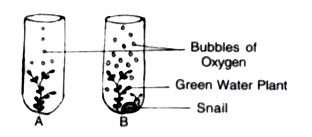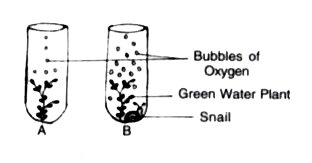The diagram below shows two test-tubes A and B. Test-tube A contains a green water plant. Test-tube B contains both a green water plant and a snail. Both Test-tubes are kept in sunlight. Answer the questions that follow :i Name the physiological process that releases the bubbles of oxygen. ii Explain the physiological process as mentioned above in Q.2 a i.iii What is the purpose of keeping a snail in test-tube B ?iv Why does test-tube B have more bubbles of oxygen ?v Give an example of a water plant that can be used in the above experiment.vi Write the overall chemical equation for the above process.
i Photosynthesisii Photosynthesis is the process by which living plant cells containing chlorophyll produce food substances glucose and starch from CO2 and water try using light energy. iii To increase the rate of photosynthesis by releasing CO2. iv When snail respires concentration of CO2 increases which enhances the rate of photosynthesis. v Hydrillavi
Related Solutions
The diagram below shows two test-tubes A and B. Test-tube A contains a green water plant. Test-tube B contains both a green water plant and a snail. Both Test-tubes are kept in sunlight. Answer the questions that follow :

Name the physiological process that releases the bubbles of oxygen.View SolutionThe diagram below shows two test-tubes A and B. Test-tube A contains a green water plant Test-tube B contains both a green water plant and a snail. Both test tubes are kept in sunlight Answer the questions that follow What is the purpose of keeping a snail in test-tube "B?
View SolutionThe diagram below shows two test-tubes A and B. Test-tube A contains a green water plant Test-tube B contains both a green water plant and a snail. Both test tubes are kept in sunlight Answer the questions that follow

Explain the physiological process as mentioned aboveView SolutionThe diagram below shows two test-tubos A and B. Test-tube A contains a green water plant Test-tube B contains both a green water plant and a snail. Both test tubes are kept in sunlight Answer the questions that follow

Name the physiological process that releases the bubbles of oxygenView SolutionThe diagram below shows two test-tubos A and B. Test-tube A contains a green water plant Test-tube B contains both a groen water plant and a snail. Both test tubes are kept n sunlight Answer the questions that follow

Why does test-tube 'B' have more bubbles of oxygenView SolutionThe diagram below shows two test-tubes A and B. Test-tube A contains a green water plant Test-tube B contains both a green water plant and a snail. Both test tubes are kept in sunlight Answer the questions that follow Write the overall chemical reaction for the above process.
View SolutionThe diagram below shows two test-tubos A and B. Test-tube A contains a green water plant Test-tube B contains both a groen water plant and a snail. Both test tubes are kept n sunlight Answer the questions that follow

Give an example of a water plant that can be used in the above experiment.View SolutionTake three test-tubes, Fill 3/4th of each with water. Label them A, B and C. Keep a snail ini test-tube A, a water plant in test-tube B and in C, keep snail and plant both. Which test-tube would have the highest concentration of ?
View SolutionTake three test tubes. Fill 3/4th of each with water. Label them A, B and C. Keep a snail in the test-tube A, a water plant in test-tube B and in C, keep snail and plant both. Which test-tube would have the highest concentraction of ?
View SolutionTake three test tubes. Fill 3//4th of each with water. Label them A,B and C. Keep a snail in test tubeA, a water plant in test-tube B and in C, keep snail and plant both. Which test-tube would have the highest concentration of?
View SolutionTake three test tubes. Fill each one up to 3/4 full with water. Mark them as A, B and C. Place a snail in test tube A. Put an aquatic plant in test tube B and place both a snail and a plant in C. Which test tube will have the highest concentration of carbon dioxide?
View SolutionTake three test-tubes. Fill 3/4th of each with water. Label them A, B and C. Keep a snail in test-tube A, a water plant in testtube B and in C, keep snail and plant both. Which test-tube would have the highest concentration of ?
View SolutionTake three test tubes .Fill in 3/4th of eacg with water.Label them A,BandC.Keep a snail in test tube A,a water plant in test tube B and in C ,Keep snail and plant both.Which test-tube would have the highest concentration of CO2?
View Solutionतीन परखनलियाँ लीजिए। प्रत्येक को भाग तक जल से भर लीजिए। इन्हें A, B तथा C द्वारा चिहनित कीजिए। परखनली A में एक घोंघा रखिए। परखनली B में कोई जलीय पादप रखिए और C में और पादप दोनों को रखिए। किस परखनली में कार्बन डाइऑक्साइड की सांद्रता सबसे अधिक होगी?
View SolutionYou have two test tubes A and B. Test tube A contains paste of turmeric, whereas test tube B contains aqueous solution of phenolphthalein. On adding a few drops of dilute hydrochloric acid to these test tubes the contents of
View SolutionYou have two test tubes 'A' and 'B'. Test tube 'A' contains paste of turmeric whereas test tube 'B' contains aqueous solution of phenolphthalein. On adding a few drops of dilute hydrochloric acid to these test tubes the contents of:
View Solutionपरखनली A तथा B में समान लंबाई के Mg की पट्टी लें। परखनली 'A' में HCI तथा परखनली 'B' में डालिए । किस परखनली में अत्यधिक तेजी से बुदबुदाहट होगी तथा क्यों?
View SolutionTwo test tubes. 'A' and 'B' contains iron nails. In 'A' test tube iron nail is half dipped with water and in 'B' test tube iron nail is completely dipped in water and some oil also added. Then
View SolutionMohan takes 5 mL of distilled water in four test tubes A, B, C and D. He dissolves sodium chloride in test tube A, calcium chloride in test tube B, magnesium chloride in test tube C and potassium chloride in test tube D. In which test tube(s) will scum be formed with soap?
View SolutionKanchi takes 5 mL of distilled water in four test tubes A, B, C and D. She dissolves sodium chloride in test tube A, potassium chloride in test tube B, calcium chloride in test tube C and magnesium chloride in test tube D. In which test tubes will soap give lather?
View Solution
